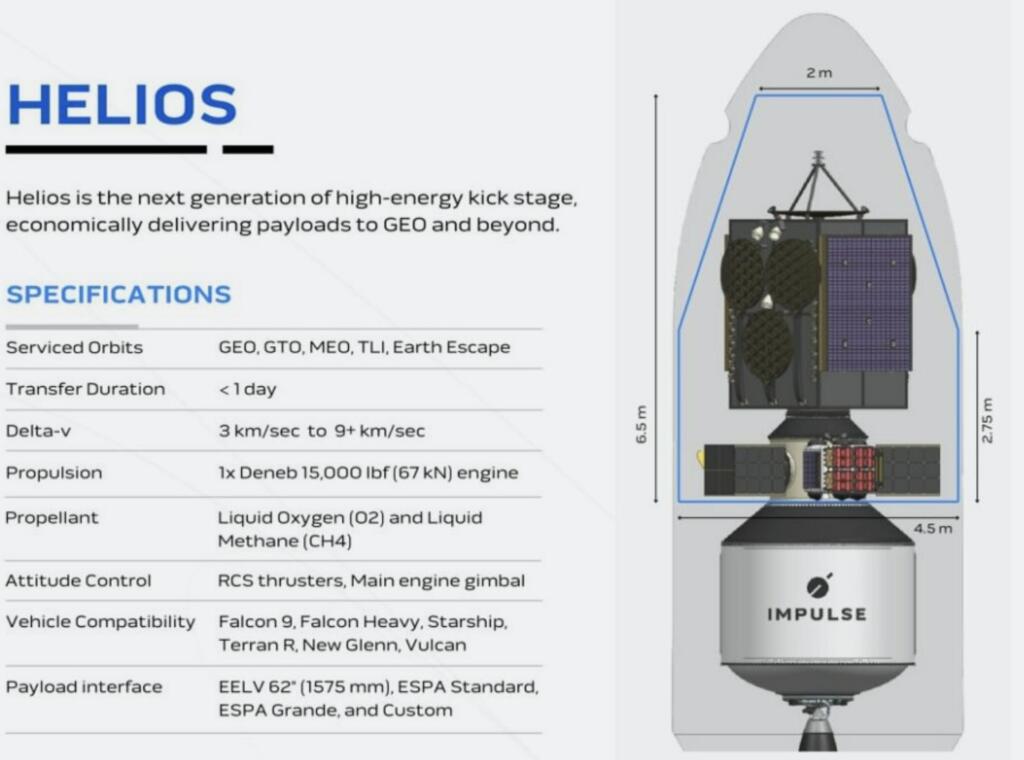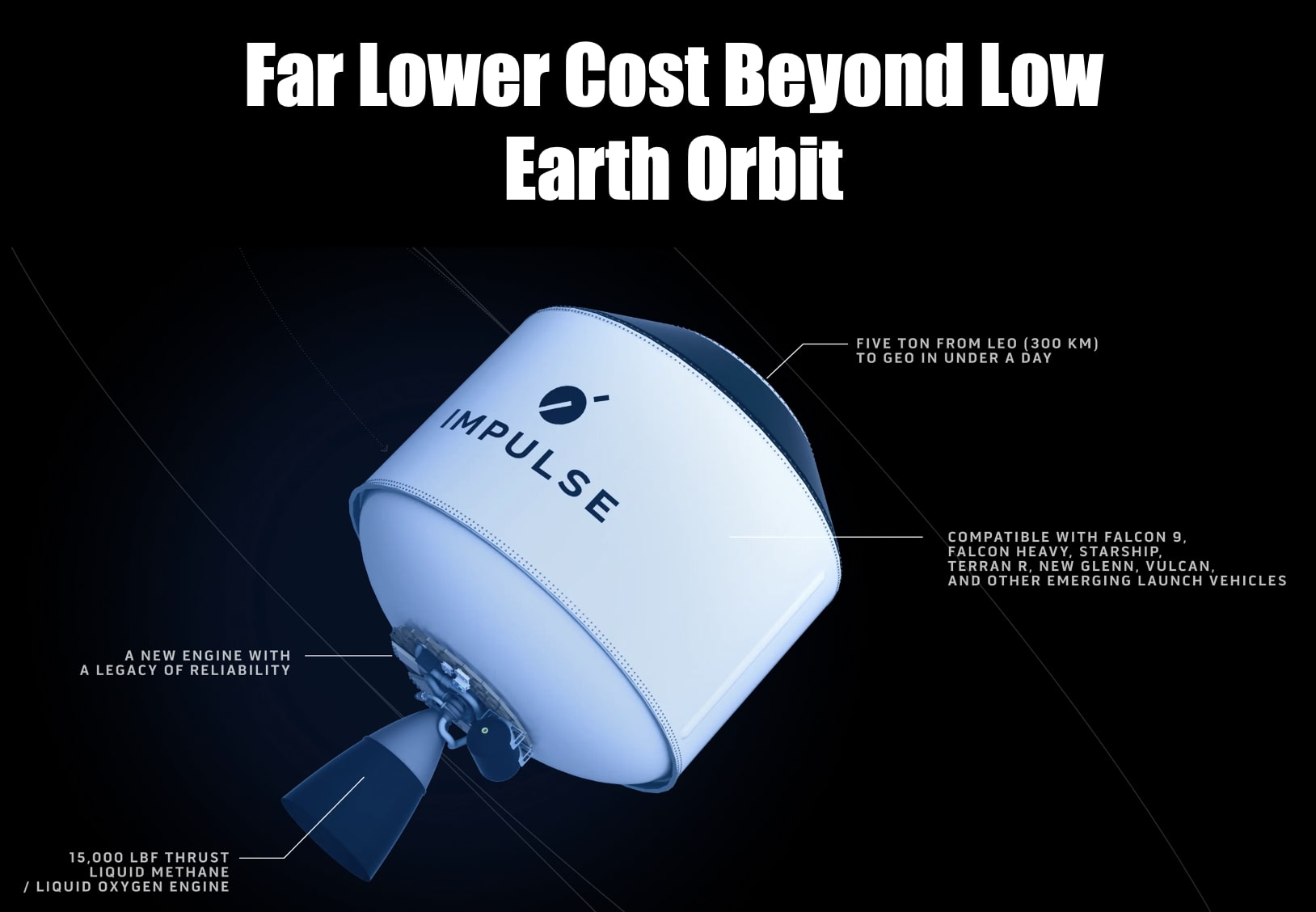Impulse Space has x-SpaceX founders and has $45 million of funding to develop space tugs that would move payloads to higher orbits. Founded in 2021, Impulse Space is providing agile, economical space logistics services. With a near-term focus on Low Earth Orbit (LEO), services include in-space transportation to custom orbits, in-space payload hosting and space asset repositioning services including deorbiting. Long-term, Impulse will offer services for all classes of payloads to distant destinations such as Geostationary Equatorial Orbit (GEO), the Moon, and Mars.
Tom Mueller, chief executive of Impulse Space and one of the founding employees of SpaceX, said Helios wants to extend the capabilities of vehicles like SpaceX’s Falcon 9 to higher orbits.

“SpaceX really got the party started by opening up access to LEO,” Tom Mueller said in an interview. “What Impulse wants to do is what SpaceX did for LEO, but for everything else, all the other high-energy orbits.”
Helios would serve as an additional stage for the Falcon 9. It would transport satellites to GEO in less than 24 hours. It would move two-thirds of the mass capability of a Falcon Heavy launching to GEO by using a Falcon 9.
From 2017 to early 2022, the SpaceX Falcon Heave price was US$150 million for 63.8 t (141,000 lb) to LEO or 26.7 t (59,000 lb) to GTO (fully expendable). This equates to a price of US$2,350 per kg to LEO and US$5,620 per kg to GTO. In 2022, a reusable Falcon Heavy launch was $97 million. This reduces the prices to $1600 per kg to LEO and $4200 per kg to GTO.
It costs about $56m-62 million for Falcon 9 flight. If satellite was 5-22 tons and the Helios only chaged about $20 million then your mission to GEO would be cheaper using Falcon 9 and Helios versus Falcon Heavy.
The stage will be powered by an engine called Deneb, producing 15,000 pounds-force of thrust. Mueller said the engine components have passed a preliminary design review, and the company is on track to begin engine tests in the summer.
The first flight of Helios is planned for early 2026, with initial plans to fly the vehicle four to six times a year. Impulse has a letter of intent with an undisclosed customer and positive conversations with other potential users

Brian Wang is a Futurist Thought Leader and a popular Science blogger with 1 million readers per month. His blog Nextbigfuture.com is ranked #1 Science News Blog. It covers many disruptive technology and trends including Space, Robotics, Artificial Intelligence, Medicine, Anti-aging Biotechnology, and Nanotechnology.
Known for identifying cutting edge technologies, he is currently a Co-Founder of a startup and fundraiser for high potential early-stage companies. He is the Head of Research for Allocations for deep technology investments and an Angel Investor at Space Angels.
A frequent speaker at corporations, he has been a TEDx speaker, a Singularity University speaker and guest at numerous interviews for radio and podcasts. He is open to public speaking and advising engagements.


I thought the commercial GEO industry is getting the rug pulled out from under it by Starlink so hard future large GEO launch orders have flatlined already? At this rate, only medium/small GEO seems to still be alive on the commercial side, which can be covered by second stage GTO launch easily enough. Who in the commercial side needs a 24 hour GEO delivery window anyways?
This seems geared for “commercial” lunar launch. Nothing wrong with that. Just that some people are smelling the Artemis pork gravy train and gearing up for it.
SpaceX should develop a high performance methane rocket engine frt eh second stage falcon 9 / Falcon heavy.
If you think Lynchburg is some poor, Appalachian backwater, you are sorely out of touch. It’s a hundred miles east of Virginia Tech, which is a major engineering college.
Oh, sorry. I only lived there and worked for BWXT for 5 years – I have no idea of the depth of talent they have at their command /s.
If you think BWXT will deliver anything besides the scheduled reloads of submarine and DOE reactors then you are out of touch with wishful thinking.
Do a google search of BWXT and the top 100 returns are for stock analysis. It is a single source supplier of pork.
This looks much more reasonable (methalox) than expecting some $20M nuclear rocket motor designed/built in Appalachia (Lynchburg, VA) to fill the role.